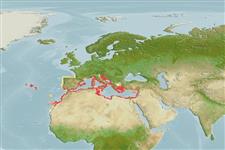Élasmobranches (requins et raies) (sharks and rays) >
Carcharhiniformes (Ground sharks) >
Triakidae (Houndsharks) > Triakinae
Etymology: Mustelus: Latin for weasel, an ancient name for sharks, possibly referring to the pointed snouts, swift movements and/or rapacious feeding behavior of smaller predatory sharks [strictly not tautonymous with Squalus mustelus Linnaeus 1758 since type was designated by the ICZN]. (See ETYFish); punctulatus: Diminutive of punctum (L.), spot, i.e., having tiny spots, referring to small black spots often present on body. (See ETYFish).
More on author: Risso.
Environment: milieu / climate zone / depth range / distribution range
Écologie
marin démersal. Subtropical; 45°N - 20°N
Eastern Atlantic: Mediterranean to Western Sahara. Confused with Mustelus mustelus and most data for this species were in part attributable to Mustelus mediterraneus.
Length at first maturity / Taille / Poids / Âge
Maturity: Lm 95.0, range 60 - 100 cm
Max length : 190 cm TL mâle / non sexé; (Ref. ); common length : 120 cm TL mâle / non sexé; (Ref. )
An inshore, continental bottom-dwelling shark. Probably a crustacean feeder. Presumably viviparous.
Life cycle and mating behavior
Maturité | Reproduction | Frai | Œufs | Fécondité | Larves
Probably viviparous (Ref. 244). Distinct pairing with embrace (Ref. 205).
Compagno, L.J.V., 1984. FAO Species Catalogue. Vol. 4. Sharks of the world. An annotated and illustrated catalogue of shark species known to date. Part 2 - Carcharhiniformes. FAO Fish. Synop. 125(4/2):251-655. Rome: FAO. (Ref. 244)
Statut dans la liste rouge de l'IUCN (Ref. 130435)
Menace pour l'homme
Harmless
Utilisations par l'homme
Pêcheries: commercial
Plus d'informations
Taille/ÂgeCroissanceLongueur-poidsLongueur-longueurFréquences de longueursMorphométrieMorphologieLarvesDynamique des populations larvairesRecrutementAbondanceBRUVS
RéférencesAquacultureProfil d'aquacultureSouchesGénétiqueElectrophoresesHéritabilitéPathologiesTraitementNutrientsMass conversion
CollaborateursImagesStamps, Coins Misc.SonsCiguateraVitesseType de nageSurface branchialeOtolithesCerveauxVision
Outils
Articles particuliers
Télécharger en XML
Sources Internet
Estimates based on models
Preferred temperature (Ref.
123201): 15.3 - 21.6, mean 18.8 °C (based on 182 cells).
Phylogenetic diversity index (Ref.
82804): PD
50 = 0.5000 [Uniqueness, from 0.5 = low to 2.0 = high].
Bayesian length-weight: a=0.00347 (0.00219 - 0.00549), b=3.16 (3.03 - 3.29), in cm total length, based on LWR estimates for this species & Genus-body shape (Ref.
93245).
Niveau trophique (Ref.
69278): 3.8 ±0.4 se; based on diet studies.
Generation time: 3.3 ( na - na) years. Estimated as median ln(3)/K based on 1
growth studies.
Résilience (Ref.
120179): Faible, temps minimum de doublement de population : 4,5 à 14 années (tm=1.3-2.6(?); Fecundity is presumably low like other Mustelus species).
Fishing Vulnerability (Ref.
59153): Moderate to high vulnerability (51 of 100).
Nutrients (Ref.
124155): Calcium = 15.9 [4.3, 80.9] mg/100g; Iron = 0.485 [0.153, 1.866] mg/100g; Protein = 22.1 [19.7, 24.4] %; Omega3 = 0.144 [0.057, 0.357] g/100g; Selenium = 54.4 [14.4, 196.5] μg/100g; VitaminA = 3.8 [1.2, 12.1] μg/100g; Zinc = 0.461 [0.202, 0.945] mg/100g (wet weight);
